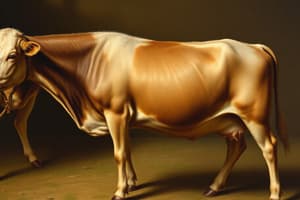Podcast
Questions and Answers
What seasonal pattern characterizes the sheep industry's production system?
What seasonal pattern characterizes the sheep industry's production system?
Mating in autumn and lambing in spring.
How do sheep's reproductive cycles respond to environmental cues?
How do sheep's reproductive cycles respond to environmental cues?
Decreased day length stimulates the reproductive cycle.
What are the three main types of farms in the UK sheep industry?
What are the three main types of farms in the UK sheep industry?
Hill farms, upland farms, and lowland farms.
What is the significance of cross-breeding in sheep production?
What is the significance of cross-breeding in sheep production?
What is the role of a Draft Hill ewe in sheep production?
What is the role of a Draft Hill ewe in sheep production?
What are the advantages of stratification in sheep production?
What are the advantages of stratification in sheep production?
What happens during scanning at 90 days in the annual production cycle?
What happens during scanning at 90 days in the annual production cycle?
What is a key challenge currently facing the sheep industry?
What is a key challenge currently facing the sheep industry?
How does the diverse environment affect sheep breeds and production?
How does the diverse environment affect sheep breeds and production?
Why is biosecurity a concern in the stratification of the sheep industry?
Why is biosecurity a concern in the stratification of the sheep industry?
Flashcards
Seasonal Sheep Production
Seasonal Sheep Production
Mating in autumn, lambing in spring to align with high-quality grass availability.
Day Length Impact on Ewes
Day Length Impact on Ewes
Decreased day length triggers reproductive cycles in ewes, leading to natural heat.
Hill Farms (Sheep)
Hill Farms (Sheep)
Located in mountainous areas; utilize unimproved pastures with harsher climates and high rainfall.
Upland Farms (Sheep)
Upland Farms (Sheep)
Signup and view all the flashcards
Lowland Farms (Sheep)
Lowland Farms (Sheep)
Signup and view all the flashcards
Stratification (Sheep)
Stratification (Sheep)
Signup and view all the flashcards
Draft Hill Ewe
Draft Hill Ewe
Signup and view all the flashcards
Longwool Ram Influence
Longwool Ram Influence
Signup and view all the flashcards
Mule Lambs
Mule Lambs
Signup and view all the flashcards
Advantages of Stratification
Advantages of Stratification
Signup and view all the flashcards
Study Notes
The Sheep Industry
- Seasonal production system: mating occurs in autumn while lambing is in spring; high-quality grass in spring supports lambing.
- Decreased day length triggers sheep's reproductive hormone cycle, leading to natural heat in ewes.
- Ewes require increased nutritional intake of high-quality food during lambing and lactation.
UK Seasonal Grass Growth
- Peak grass growth typically occurs around early May.
- A significant portion of grass is transformed into livestock products through ruminants.
- Extra grass is conserved for hay or silage to align production with animal feeding demands.
Structure of the UK Sheep Industry
- Hill farms: Located in mountainous areas; utilize unimproved pastures with harsher climates and high rainfall.
- Upland farms: Feature a mix of unimproved and improved pastures for grazing.
- Lowland farms: Adopt improved pastures; capable of ploughing and silage production to support more productive livestock.
Stratification in Sheep Production
- Defined as a three-tier breeding structure linked to altitude and grazing conditions.
- Involves spatial distribution of breeding components and cross-breeding for advantageous traits.
- Traits from different breeds can enhance overall performance and adaptability in varying environments.
- Cross-breeding: Promotes heterosis, improving health and production by using desirable traits.
Replacements in Sheep Breeding
- Structured breeding diagram highlights pathways for lamb development from various ewe and ram combinations.
- Draft Hill ewe: Grows in hill environments and is later sold to upland settings for continued lamb production.
- Longwool ram x Draft Hill ewe: Increases the likelihood of twins or triplets and boosts milk production.
- Mule lambs: Result from crossing Draft Hill ewes and Longwool rams, noted for being hardy and highly maternal.
- Migrated mules into lowland areas incorporate terminal sire genetics for high meat yields; all offspring from these sires are typically slaughtered.
Advantages of Stratification
- Adaptable sheep production strategies tailored to diverse environmental conditions.
- Utilization of varying types of land to enhance productivity.
- Hybrid vigor is promoted through cross-breeding across different breeding tiers.
- Creates interconnected networks across various sectors of sheep farming.
- Facilitates the conservation of local sheep breeds.
Disadvantages of Stratification
- Risks to biosecurity may arise from interconnected systems.
- Issues affecting one sector can ripple through others due to dependency structures.
- Lowland farmers may shift back to maintaining exclusive breeding stocks.
Annual Production Cycle
- The annual cycle begins with tupping (mating), establishing a timeline for the production year.
- Scanning at 90 days helps determine ewe's nutritional needs, adjusting for prolificacy levels.
Challenges to the Industry
- Declining lamb consumption poses a significant challenge for the sheep industry.
Studying That Suits You
Use AI to generate personalized quizzes and flashcards to suit your learning preferences.




